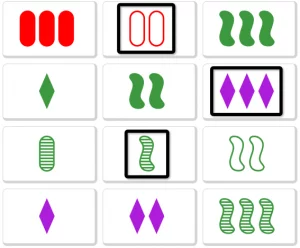Aesthetics: challenge, sensation (speed)
Dynamics: time pressure, opponent play
Mechanics: shuffling cards, “rounds” of dealing cards, four card attributes with three values each
Set is a pattern recognition game that can be played alone and with any number of players. It has captured my attention for years – I was introduced to it by my family when I was about six years old, and it has continued to be one of my favorite games to play. Set is a card game with values that display combinations of shape (oval, diamond, and squiggle), color (red, green, purple), number (one, two, or three shapes), and pattern (solid, striped, or empty). Cards are shuffled and laid out in 12 cards at a time, and players shout “Set” when they identify a three-card set, replacing the three cards with new cards from the deck. Players collect sets that are correct and whichever player has the most “sets” when the deck is played through wins. The game relies on players’ speed to create a competitive environment, as players are trying to beat the other players in the game by claiming sets on the board before another player can either claim the same set, or a different set that could use a card that is required for your set.
Although the mechanics are quite simple and are mainly focused on shuffling the cards and speed, you can therefore create a timed challenge for yourself (i.e. timing yourself to see how fast you alone can go through the entire deck) or play against others to see who can identify sets faster. It can scale to any number of players since all players solely interact with the twelve cards presented on the table and just have to shout “Set” to engage in gameplay. This range in player number allows the game to take on different game environments; playing by yourself can almost turn the game into a “submission” aesthetic, while playing against any opponent takes on more of the “challenge” aesthetic. Additionally, because the deck consists of 81 unique cards, it is pretty much impossible to have the same “game board” or order of cards laid out, so each game continues to have an air of novelty to it.
As I have played this game more, what has been interesting to see is that although the mechanics of the game are fairly simple (shuffling and four varying card features), players gravitate towards different types of sets based on their pattern-recognition skills. Some people are better at seeing sets where the values in all four features are different (my personal strength), while others are better at identifying sets that have the same value in the four features. For example, I am more easily able to identify sets that consist of cards that have all different numbers of shapes, different colors, different shapes, and different patterns (1 red solid diamond, 2 purple empty squiggles, and 3 green striped ovals). My friends have been more easily able to identify sets such as 2 purple solid ovals, 2 green solid diamonds, and 2 red solid squiggles. Having a challenge game that allows players to succeed based on their different strengths is really exciting, since the mechanics allow players to contribute significantly to the inter-personal player dynamics (in my opinion, most games should try and harness different players’ strengths/weaknesses, and I think Set does this very well). Even my friends who do not love “brain teaser” or “puzzle” games have found this game fun and have remarked that they want to “get better at it,” demonstrating that the challenge presented is at the right difficulty range for a variety of players.

Example of an “all different” set.


